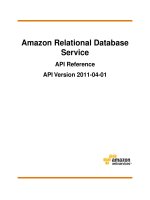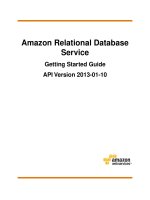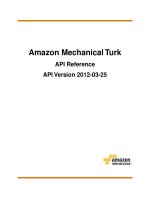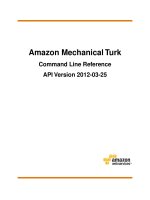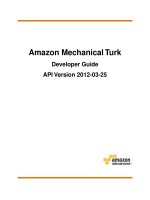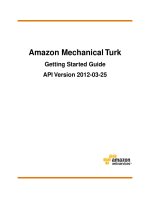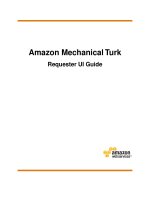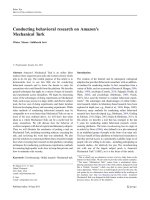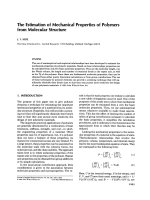Amazon Mechanical Turk API Reference API Version 2012-03-25 ppt
Bạn đang xem bản rút gọn của tài liệu. Xem và tải ngay bản đầy đủ của tài liệu tại đây (1.16 MB, 232 trang )
Amazon Mechanical Turk
API Reference
API Version 2012-03-25
Amazon Web Services
Amazon Mechanical Turk API Reference
Amazon Mechanical Turk: API Reference
Amazon Web Services
Copyright © 2013 Amazon Web Services, Inc. and/or its affiliates. All rights reserved.
The following are trademarks of Amazon Web Services, Inc.: Amazon, Amazon Web Services Design, AWS,
Amazon CloudFront, Cloudfront, Amazon DevPay, DynamoDB, ElastiCache, Amazon EC2, Amazon Elastic
Compute Cloud, Amazon Glacier, Kindle, Kindle Fire, AWS Marketplace Design, Mechanical Turk, Amazon
Redshift, Amazon Route 53, Amazon S3, Amazon VPC. In addition, Amazon.com graphics, logos, page
headers, button icons, scripts, and service names are trademarks, or trade dress of Amazon in the U.S.
and/or other countries. Amazon's trademarks and trade dress may not be used in connection with any
product or service that is not Amazon's, in any manner that is likely to cause confusion among customers,
or in any manner that disparages or discredits Amazon.
All other trademarks not owned by Amazon are the property of their respective owners, who may or may
not be affiliated with, connected to, or sponsored by Amazon.
Amazon Mechanical Turk API Reference
Welcome 1
WSDL and Schema Locations 2
Common Parameters 6
Operations 10
ApproveAssignment 11
ApproveRejectedAssignment 13
AssignQualification 14
BlockWorker 16
ChangeHITTypeOfHIT 19
CreateHIT 21
CreateQualificationType 32
DisableHIT 36
DisposeHIT 38
DisposeQualificationType 40
ExtendHIT 42
ForceExpireHIT 45
GetAccountBalance 47
GetAssignment 49
GetAssignmentsForHIT 52
GetBlockedWorkers 55
GetBonusPayments 58
GetFileUploadURL 61
GetHIT 63
GetHITsForQualificationType 65
GetQualificationsForQualificationType 68
GetQualificationRequests 71
GetQualificationScore 74
GetQualificationType 76
GetRequesterStatistic 78
GetRequesterWorkerStatistic 83
GetReviewableHITs 87
GetReviewResultsForHIT 90
GrantBonus 98
GrantQualification 101
Help 103
NotifyWorkers 106
RegisterHITType 108
RejectAssignment 111
RejectQualificationRequest 113
RevokeQualification 115
SearchHITs 117
SearchQualificationTypes 120
SendTestEventNotification 124
SetHITAsReviewing 126
SetHITTypeNotification 128
UnblockWorker 131
UpdateQualificationScore 133
UpdateQualificationType 135
Data Structures 139
Assignment 139
HIT 143
HITLayoutParameter 148
HIT Review Policy 149
Locale 153
Price 154
Qualification 156
QualificationRequest 158
QualificationRequirement 160
API Version 2012-03-25
4
Amazon Mechanical Turk API Reference
QualificationType 167
Notification 170
WorkerBlock 172
Review Policies 173
How Review Policies Work 173
Assignment Review Policies 174
HIT Review Policies 176
Review Policy Use Cases 179
Question and Answer Data 185
Using XML Parameter Values 186
QuestionForm 187
Formatted Content: XHTML 201
QuestionFormAnswers 207
AnswerKey 208
ExternalQuestion 212
HTMLQuestion 216
HITLayout 219
The Notification API 221
Elements of a Notification Message 221
Notification Handling Using Amazon SQS 222
Document History 226
API Version 2012-03-25
5
Amazon Mechanical Turk API Reference
Welcome
This is the Amazon Mechanical Turk API Reference. This guide provides detailed information about
Amazon Mechanical Turk operations, data structures, and parameters.The major sections of this guide
are described in the following table.
Amazon Mechanical Turk is a web service that provides an on-demand, scalable, human workforce to
complete jobs that humans can do better than computers, for example, recognizing objects in photos.
For more information about this product go to Amazon Mechanical Turk.
Alphabetical list of all Amazon Mechanical Turk operations.Operations (p. 10)
Alphabetical list of all Amazon Mechanical Turk data
structures.
Data Structures (p. 139)
Descriptions of the parameters common to all operations.Common Parameters (p. 6)
Links to Amazon Mechanical Turk WSDL and schemas.WSDL and Schema Locations (p. 2)
Description of Amazon Mechanical Turk Review Policies.Review Policies (p. 173)
Description of question and answer data that Amazon
Mechanical Turk passes between Requesters and Workers.
Question and Answer Data (p. 185)
Description of how Amazon Mechanical Turk sends notification
messages to your application.
The Notification API (p. 221)
API Version 2012-03-25
1
Amazon Mechanical Turk API Reference
WSDL and Schema Locations
Topics
• The WSDL and Message Schema Locations (p. 3)
• The Data Structure Schema Locations (p. 3)
• The Formatted Content XHTML Subset (p. 4)
• The Notification API WSDL Location (p. 4)
• Service API Versions (p. 4)
• Accessing a Specific Service Version (p. 5)
• The Default Version (p. 5)
The Amazon Mechanical Turk Service can be accessed using the SOAP web services messaging protocol,
or using the REST method of HTTP requests with parameters.The SOAP interface is described by a
Web Services Description Language (WSDL) document. REST requests return messages that conform
to an XML Schema document.
To make it easy to upgrade your application when a new version of schemas are released, all schemas
have a version number.The version number appears in the URL of a schema file, and in a schema's
target namespace.The API schemas (the WSDL and request/response messages) and the data structure
schemas (question and answer values) use separate version numbers.The latest versions are as follows:
Latest VersionType of Schema
2012-03-25The API: WSDL and message schemas
2011-11-11The HTMLQuestion schema
2005-10-01The QuestionForm, QuestionFormAnswers and
AnswerKey schemas
2006-07-14The ExternalQuestion schema
2006-07-14The formatted content XHTML subset
2006-05-05The Notification API
API Version 2012-03-25
2
Amazon Mechanical Turk API Reference
The WSDL and Message Schema Locations
The WSDL for a given version of the Amazon Mechanical Turk Service API can be found at a URL that
corresponds to the API version. For example, the WSDL for the 2012-03-25 version of the API can be
found here:
/>The XML Schema for the messages of a given version of the Amazon Mechanical Turk Service API can
be found at a URL that corresponds to the API version. For example, the XML Schema for the 2012-03-25
version of the API can be found here:
/>The Data Structure Schema Locations
The Amazon Mechanical Turk Service has several parameters and return values that contain XML data.
The XML content must validate against the appropriate XML schema. For more information, see
HTMLQuestion (p.216), QuestionForm (p.187), QuestionFormAnswers (p.207), and AnswerKey (p.208).
Note
The API version number and the data structure version number are not related.The two sets of
schemas may have new releases at different times, and may have different version numbers.
For example, an application using the 2012-03-25 version of the API may create HITs using
the 2005-10-01 version of the QuestionForm schema. (There may not be a "2012-03-25"
version of the QuestionForm schema.)
Your application may use any supported version of the data schemas with any supported version
of the API. A data structure returned by the service will include a namespace that corresponds
to the relevant schema.
The 2011-11-11 version of the HTMLQuestion schema can be found here:
/>The 2005-10-01 version of the QuestionForm schema can be found here:
/>The 2005-10-01 version of the QuestionFormAnswers schema can be found here:
/>The 2005-10-01 version of the AnswerKey schema can be found here:
/>The 2006-07-14 version of the ExternalQuestion schema can be found here:
/>Note
To conform to a schema, XML content must use namespace declarations that match the target
namespace for the schema. The target namespace is declared at the top of the schema, as the
"targetNamespace" attribute of the "xs:schema" element.
The schemas for QuestionForm, QuestionFormAnswers, and AnswerKey use namespace URIs
similar to the URL at which the schema file can be found, including the service version. For
example:
API Version 2012-03-25
3
Amazon Mechanical Turk API Reference
The WSDL and Message Schema Locations
<QuestionForm
xmlns="
as/2005-10-01/QuestionForm.xsd"
>
[ ]
</QuestionForm>
If the service returns an error message about data not validating against the schema, make sure
your namespace declaration matches the target namespace specified in the schema.
The Formatted Content XHTML Subset
HITs and Qualification tests can include blocks of content formatted with XHTML tags in their instructions
and question data.To include text and markup for formatted content in a web service request, you specify
it as XML CDATA inside a FormattedContent element, part of the QuestionForm data structure (p.187).
Amazon Mechanical Turk validates formatted content by converting the text and markup in the CDATA
block into an XML document, then validating it against a schema. For more information about how this
XML document is produced, see Formatted Content: XHTML (p. 201), "How XHTML Formatted Content
Is Validated".
The 2006-07-14 version of the schema used to validate formatted content can be found here:
/>The Notification API WSDL Location
The WSDL for the Notification API is located at:
/>For more information about the Notification API, see The Notification API (p. 221).
Service API Versions
When a new version of the service API is released, previous versions are supported for a limited time to
allow applications to continue to function until they are upgraded.The version of a service API is specified
as a date, such as 2012-03-25.
The version of the API can be found in the URLs of the WSDL and schema files. It can also be found in
the targetNamespace of the WSDL and schema files.
You can retrieve the WSDL or schema files for previous versions of the API by replacing the version date
in the URL with the desired version. For example, to retrieve the WSDL for API version 2012-03-25:
/>For information about which versions of the API are supported, visit the Amazon Web Services web site
at />API Version 2012-03-25
4
Amazon Mechanical Turk API Reference
The Formatted Content XHTML Subset
Accessing a Specific Service Version
For your application to use a specific version of the service API, the service needs to be told which version
is being used with each request.
For SOAP requests, the Amazon Mechanical Turk Service determines which API version you are using
based on the namespace in your request message, which is determined by the WSDL you are using with
your application. SOAP requests always include this information, and SOAP toolkits determine the
namespace automatically from the WSDL.
For REST requests, you must explicitly request the version to use by including the Version parameter
in your request.The Version parameter ensures that the service does not return response elements
that your application is not designed to handle.
Here is an example REST request that includes the Version parameter:
/>&AWSAccessKeyId=[the Requester's Access Key ID]
&Version=2012-03-25
&Operation=GetHIT
&HITId=123RVWYBAZW00EXAMPLE
The Default Version
Older AWS services supported requests that did not specify an API version.This behavior is still supported
for legacy reasons, but its use is discouraged.
When the Amazon Mechanical Turk Service receives a REST request without a Version parameter, the
service will use the latest version. If your application does not specify the Version in each request, when
a new version of the API is released, your application will start using the new version automatically.
Because new versions of the API may be incompatible with applications expecting to use an older version,
specifying an explicit Version parameter with each request is strongly recommended.
A similar legacy feature exists for SOAP: A request for the WSDL or a schema file using a URL that does
not include the version number will return the file for the latest version of the API. Using WSDL/schema
URLs that include the API version number is strongly recommended.
API Version 2012-03-25
5
Amazon Mechanical Turk API Reference
Accessing a Specific Service Version
Common Parameters
Topics
• Common Request Parameters (p. 6)
• Response Groups (p. 7)
The Amazon Mechanical Turk Service accepts a set of parameters in the request common to every
operation. Each required parameter must be included in a request for the request to be successful.
Parameters common to all operations are explained in Common Request Parameters. For more
information about the parameters for a specific operation, see the description of the operation in the
Operations (p. 10) section of this reference.
Response groups specify what data is returned by Mechanical Turk for an operation request and are
explained in Response Groups (p. 7).
Common Request Parameters
Requests to the Amazon Mechanical Turk service can include the parameters described in the following
table. Required parameters must be included with each request for the request to succeed.
RequiredDescriptionName
YesThe Requester's Access Key ID, a unique identifier that
corresponds to a Secret Access Key and an Amazon.com
account.
Type: String
Default: None
AWSAccessKeyId
YesThe name of the Amazon Web Services service.
Type: String
Valid Values: AWSMechanicalTurkRequester
Default: None
Constraints: For REST requests only.
For SOAP requests the name of the service is part of the
SOAP entry point, and does not need to be specified in the
request.
Service
API Version 2012-03-25
6
Amazon Mechanical Turk API Reference
Common Request Parameters
RequiredDescriptionName
YesThe name of the operation.
Type: String
Default: None
Contraints: For REST requests only
For SOAP requests, the operation name is part of the SOAP
message structure provided by your SOAP toolkit, and is
not part of the request.
Operation
YesThe signature for this request, an encrypted string calculated
from elements of the request and the AWS access key that
corresponds to your AWS Access Key ID. For information
about how to calculate a Signature, see AWS Request
Authentication.
Type: String
Default: None
Signature
YesThe current time on your system.This value is included to
validate against the Signature parameter.
Type: a dateTime in the Coordinated Universal Time
(Greenwich Mean Time) time zone, such as
2005-01-31T23:59:59Z.
Default: None
Timestamp
YesA list of response groups. For more information about
response groups, see Response Groups (p. 7).
Type: String
Default: None
ResponseGroup
NoSpecifies what version of the API to use.
Type: String
Default: None. If not specified, the latest version of the API
is used.
Constraints: Used only for REST requests
Version
NoDeprecatedValidate
Not usedThis parameter is reserved for future use.
Type: None
Default: None
Credential
Response Groups
Response groups specify what data is returned by the service for an operation, to control the data included
in the response. Most operations in the Amazon Mechanical Turk service allow the use of two common
response groups: Minimal and Request. Minimal provides a minimal set of results of the operation
call. Request echoes the content of the original request.What gets included in Minimal varies depending
upon the API call.
The following table lists the operations that can return more response groups than Minimal and Request.
API Version 2012-03-25
7
Amazon Mechanical Turk API Reference
Response Groups
Default Response GroupsAllowable Response GroupsOperation
MinimalRequest, Minimal, HITDetail,
HITQuestion, HITAssignmentSummary
CreateHit
MinimalRequest, Minimal, AssignmentFeedback,
HITDetail, HITQuestion
GetAssignment
MinimalRequest, Minimal, AssignmentFeedbackGetAssignmentsForHIT
Minimal, HITDetail,
HITQuestion
Request, Minimal, HITDetail,
HITQuestion, HITAssignmentSummary
GetHIT
Minimal, ParametersRequest, Minimal, ParametersGetRequesterStatistic
Minimal, ParametersRequest, Minimal, ParametersGetRequesterWorkerStatistic
Minimal, HITDetail,
HITAssignmentSummary
Request, Minimal, HITDetail,
HITQuestion, HITAssignmentSummary
SearchHITS
Response Groups Content
You can use the Help (p. 103) operation to find out the following information about the response groups
for an operation.
• The default response groups returned by an operation
• The allowable response groups that can be returned by an operation
• The contents of a response group
The following table lists the elements returned in the response groups other than the Minimal and
Request groups.The table also lists the response group elements associated with each response group.
Response Group Elements (alpha order)Response Group
RequesterFeedback
For more information on this element, see the Assignment (p. 139) data
structure.
AssignmentFeedback
NumberOfAssignmentsAvailable
NumberOfAssignmentsCompleted
NumberOfAssignmentsPending
For more information on these elements, see the HIT (p.143) data structure.
HITAssignmentSummary
API Version 2012-03-25
8
Amazon Mechanical Turk API Reference
Response Groups Content
Response Group Elements (alpha order)Response Group
AssignmentDurationInSeconds
AutoApprovalDelayInSeconds
CreationTime
Description
Expiration
Keywords
HITGroupId
HITLayoutId
HITReviewStatus
HITStatus
MaxAssignments
QualificationRequirement
RequesterAnnotation
Reward
Title
For more information on these elements, see the HIT (p.143) data structure.
HITDetail
Question
For more information on this elements, see the HIT (p. 143) data structure.
HITQuestion
Statistic
TimePeriod
Parameters
API Version 2012-03-25
9
Amazon Mechanical Turk API Reference
Response Groups Content
Operations
The Amazon Mechanical Turk Service API consists of web service operations for every task the service
can perform. This section describes each operation in detail.
• ApproveAssignment (p. 11)
• ApproveRejectedAssignment (p. 13)
• AssignQualification (p. 14)
• BlockWorker (p. 16)
• ChangeHITTypeOfHIT (p. 19)
• CreateHIT (p. 21)
• CreateQualificationType (p. 32)
• DisableHIT (p. 36)
• DisposeHIT (p. 38)
• DisposeQualificationType (p. 40)
• ExtendHIT (p. 42)
• ForceExpireHIT (p. 45)
• GetAccountBalance (p. 47)
• GetAssignment (p. 49)
• GetAssignmentsForHIT (p. 52)
• GetBlockedWorkers (p. 55)
• GetBonusPayments (p. 58)
• GetFileUploadURL (p. 61)
• GetHIT (p. 63)
• GetHITsForQualificationType (p. 65)
• GetQualificationsForQualificationType (p. 71)
• GetQualificationRequests (p. 71)
• GetQualificationScore (p. 74)
• GetQualificationType (p. 76)
• GetReviewableHITs (p. 87)
• GetReviewResultsForHIT (p. 90)
• GetRequesterStatistic (p. 78)
• GetRequesterWorkerStatistic (p. 83)
• GrantBonus (p. 98)
API Version 2012-03-25
10
Amazon Mechanical Turk API Reference
• GrantQualification (p. 101)
• Help (p. 103)
• NotifyWorkers (p. 106)
• RegisterHITType (p. 108)
• RejectAssignment (p. 111)
• RejectQualificationRequest (p. 113)
• RevokeQualification (p. 115)
• SearchHITs (p. 117)
• SearchQualificationTypes (p. 120)
• SendTestEventNotification (p. 124)
• SetHITAsReviewing (p. 126)
• SetHITTypeNotification (p. 128)
• UnblockWorker (p. 131)
• UpdateQualificationScore (p. 133)
• UpdateQualificationType (p. 135)
ApproveAssignment
Description
The ApproveAssignment operation approves the results of a completed assignment.
Approving an assignment initiates two payments from the Requester's Amazon.com account: the Worker
who submitted the results is paid the reward specified in the HIT, and Amazon Mechanical Turk fees are
debited. If the Requester's account does not have adequate funds for these payments, the call to
ApproveAssignment returns an exception, and the approval is not processed.
You can include an optional feedback message with the approval, which the Worker can see in the Status
section of the web site.
Request Parameters
The ApproveAssignment operation accepts parameters common to all operations. Some common
parameters are required. See Common Parameters (p. 6) for more information.
The following parameters are specific to the ApproveAssignment operation:
RequiredDescriptionName
YesThe name of the operation
Type: String
Valid Values: ApproveAssignment
Default: None
Operation
YesThe ID of the assignment.This parameter must correspond
to a HIT created by the Requester.
Type: String
Default: None
AssignmentId
API Version 2012-03-25
11
Amazon Mechanical Turk API Reference
ApproveAssignment
RequiredDescriptionName
NoA message for the Worker, which the Worker can see in
the Status section of the web site.
Type: String
Default: None
Constraints: Can be up to 1024 characters (including
multi-byte characters).
The RequesterFeedback parameter cannot contain
ASCII characters 0-8, 11,12, or 14-31. If these characters
are present, the operation throws an
InvalidParameterValue error.
RequesterFeedback
Response Elements
A successful request for the ApproveAssignment operation returns with no errors.The response includes
the elements described in the following table. The operation returns no other data.
DescriptionName
Contains a Request element if the Request ResponseGroup is
specified.
ApproveAssignmentResult
Examples
The following example shows how to use the ApproveAssignment operation.
Sample Request
The following example approves an assignment identified by its assignment ID.
/>&AWSAccessKeyId=[the Requester's Access Key ID]
&Version=2012-03-25
&Operation=ApproveAssignment
&Signature=[signature for this request]
&Timestamp=[your system's local time]
&AssignmentId=123RVWYBAZW00EXAMPLE456RVWYBAZW00EXAMPLE
Sample Response
The following is an example response.
<ApproveAssignmentResult>
<Request>
<IsValid>True</IsValid>
</Request>
</ApproveAssignmentResult>
API Version 2012-03-25
12
Amazon Mechanical Turk API Reference
Response Elements
ApproveRejectedAssignment
Description
The ApproveRejectedAssignment operation approves an assignment that was previously rejected.
ApproveRejectedAssignment works only on rejected assignments that were submitted within the
previous 30 days and only if the assignment's related HIT has not been disposed.
Approving the rejected assignment initiates two payments from the Requester's Amazon.com account:
one payment to the Worker who submitted the results for the reward amount specified in the HIT and one
payment for Amazon Mechanical Turk fees. For the operation to succeed, a Requester must have sufficient
funds in their account to pay the Worker and the fees.
If the assignment is not currently rejected, or if the Requester does not have sufficient funds in their
account to pay the Worker and the Mechanical Turk fees, then the ApproveRejectedAssignment
operation returns an exception and the approval is not processed.
You can include an optional feedback message with the approval, which the Worker can see in the Status
section of the Amazon Mechanical Turk website.
Request Parameters
The ApproveRejectedAssignment operation accepts parameters common to all operations. Some
common parameters are required. For more information, see Common Parameters (p. 6).
The following parameters are specific to the ApproveRejectedAssignment operation:
RequiredDescriptionName
YesThe name of the operation.
Type: String
Valid Values: ApproveRejectedAssignment
Default: None
Operation
YesThe ID of the assignment.This parameter must correspond
to a HIT created by the Requester.
Type: String
Default: None.
AssignmentId
NoA message for the Worker, which the Worker can see in
the Status section of the Mechanical Turk website.
Type: String
Default: None.
Constraints: Can be up to 1024 characters (including
multi-byte characters).
The RequesterFeedback parameter cannot contain
ASCII characters 0-8, 11,12, or 14-31. If these characters
are present, the operation throws an
InvalidParameterValue error.
RequesterFeedback
API Version 2012-03-25
13
Amazon Mechanical Turk API Reference
ApproveRejectedAssignment
Response Elements
A successful request for the ApproveRejectedAssignment operation returns with no errors. The
response includes the elements described in the following table. The operation returns no other data.
DescriptionName
Contains a Request element if the Request ResponseGroup is
specified.
ApproveRejectedAssignmentResult
Examples
The following example shows how to use the ApproveRejectedAssignment operation.
Sample Request
The following example approves a previously rejected assignment identified by its assignment ID.
/>&AWSAccessKeyId=[the Requester's Access Key ID]
&Version=2012-03-25
&Operation=ApproveRejectedAssignment
&Signature=[signature for this request]
&Timestamp=[your system's local time]
&AssignmentId=123RVWYBAZW00EXAMPLE456RVWYBAZW00EXAMPLE
Sample Response
The following is an example response.
<ApproveRejectedAssignmentResult>
<Request>
<IsValid>True</IsValid>
</Request>
</ApproveRejectedAssignmentResult>
AssignQualification
Description
The AssignQualification operation gives a Worker a Qualification. AssignQualification does
not require that the Worker submit a Qualification request. It gives the Qualification directly to the Worker.
You can assign a Qualification to any Worker who has submitted one of your HITs in the past.
You can only assign a Qualification of a Qualification type that you created (using the
CreateQualificationType (p. 32) operation).
API Version 2012-03-25
14
Amazon Mechanical Turk API Reference
Response Elements
Tip
AssignQualification does not affect any pending Qualification requests for the Qualification
by the Worker. If you assign a Qualification to a Worker, then later grant a Qualification request
made by the Worker, the granting of the request may modify the Qualification score. To resolve
a pending Qualification request without affecting the Qualification the Worker already has, reject
the request with the RejectQualificationRequest (p. 113) operation.
Request Parameters
The AssignQualification operation accepts parameters common to all operations. Some common
parameters are required. See CommonParameters (p. 6) for more information.
The following parameters are specific to the AssignQualification operation:
RequiredDescriptionName
YesThe name of the operation
Type: String
Valid Values: AssignQualifcation
Default: None
Operation
YesThe ID of the Qualification type to use for the assigned
Qualification.
Type: String
Default: None
Constraints: must be a valid Qualification type ID, as
returned by the CreateQualificationType (p.32) operation.
QualificationTypeId
YesThe ID of the Worker to whom the Qualification is being
assigned. Worker IDs are included with submitted HIT
assignments and Qualification requests.
Type: String
Default: None
WorkerId
NoThe value of the Qualification to assign.
Type: Integer
Default: 1
IntegerValue
NoSpecifies whether to send a notification email message to
the Worker saying that the qualification was assigned to
the Worker.
Type: Boolean
Valid Values: true | false.
Default: true
SendNotification
Response Elements
A successful request for the AssignQualification operation returns with no errors. The response includes
the elements described in the following table. The operation returns no other data.
API Version 2012-03-25
15
Amazon Mechanical Turk API Reference
Request Parameters
DescriptionName
Contains a Request element if the Request ResponseGroup is
specified.
AssignQualificationResult
Examples
The following example shows how to use the AssignQualification operation.
Sample Request
The following example assigns a Qualification of a specified type to a Worker with the specified ID, using
the specified Qualification value. By default, Amazon Mechanical Turk sends the Worker an e-mail
message saying that the Worker has received the Qualification.
/>&AWSAccessKeyId=[the Requester's Access Key ID]
&Version=2012-03-25
&Operation=AssignQualification
&Signature=[signature for this request]
&Timestamp=[your system's local time]
&QualificationTypeId=789RVWYBAZW00EXAMPLE
&WorkerId=AZ3456EXAMPLE
&IntegerValue=800
Sample Response
The following is an example response.
<AssignQualificationResult>
<Request>
<IsValid>True</IsValid>
</Request>
</AssignQualificationResult>
BlockWorker
Description
The BlockWorker operation allows you to prevent a Worker from working on your HITs. For example,
you can block a Worker who is producing poor quality work.You can block up to 100,000 Workers.
You need the Worker ID to use this operation.You can get the Worker ID in the assignment data returned
by a call to the GetAssignmentsForHIT (p. 52) operation. If the Worker ID is missing or invalid, this
operation returns with the failure message "WorkerId is invalid." If the Worker is already blocked, this
operation returns successfully.
API Version 2012-03-25
16
Amazon Mechanical Turk API Reference
Examples
Request Parameters
The BlockWorker operation accepts parameters common to all operations. Some common parameters
are required. See Common Parameters (p. 6) for more information.
The following parameters are specific to the BlockWorker operation:
RequiredDescriptionName
YesThe name of the operation
Type: String
Valid Values: BlockWorker
Default: None
Operation
YesThe ID of the Worker to block.
Type: String
Default: None
WorkerId
YesA message explaining the reason for blocking the Worker.
This parameter enables you to keep track of your Workers.
The Worker does not see this message.
Type: String
Default: None
Reason
Response Elements
A successful request for the BlockWorker operation returns with no errors. The response includes the
elements described in the following table. The operation returns no other data.
DescriptionName
Contains a Request element if the Request ResponseGroup is
specified.
BlockWorkerResult
Examples
The following example shows how to use the BlockWorker operation.
Sample Request
The following example blocks a Worker from working on your HITs.
/>&AWSAccessKeyId=[the Requester's Access Key ID]
&Version=2012-03-25
&Operation=BlockWorker
&Signature=[signature for this request]
&Timestamp=[your system's local time]
&WorkerId=AZ3456EXAMPLE
&Reason=After%20several%20warnings,%20he%20continued%20to%20submit%20an
API Version 2012-03-25
17
Amazon Mechanical Turk API Reference
Request Parameters
swers%20without%20reading%20the%20instructions%20carefully.
Sample Response
The following is an example response.
<BlockWorkerResult>
<Request>
<IsValid>True</IsValid>
</Request>
</BlockWorkerResult>
Related Operations
To unblock a Worker use the UnblockWorker (p. 131) operation.
API Version 2012-03-25
18
Amazon Mechanical Turk API Reference
Related Operations
ChangeHITTypeOfHIT
Description
The ChangeHITTypeOfHIT operation allows you to change the HITType properties of a HIT. This
operation disassociates the HIT from its old HITType properties and associates it with the new HITType
properties. The HIT takes on the properties of the new HITType in place of the old ones. For more
information about HIT types, see the Amazon Mechanical Turk Developer Guide.
You can use ChangeHITTypeOfHIT to update any of the HITType properties of a HIT. All properties
except for Reward can be updated at any time.
Request Parameters
The ChangeHITTypeOfHIT operation accepts parameters common to all operations. Some common
parameters are required. See Common Parameters (p. 6) for more information.
The following parameters are specific to the ChangeHITTypeOfHIT operation:
RequiredDescriptionName
YesThe name of the operation
Type: String
Valid Values: ChangeHITTypeOfHIT
Default: None
Operation
YesThe ID of the HIT to change
Type: String
Default: None
HITId
YesThe ID of the new HIT type
Type: String
Default: None
HITTypeId
Response Elements
A successful request for the ChangeHITTypeOfHIT operation returns with no errors. The response
includes the elements described in the following table. The operation returns no other data.
DescriptionName
Contains a Request element if the Request ResponseGroup is
specified.
ChangeHITTypeOfHITResult
Examples
The following example shows how to use the ChangeHITTypeOfHIT operation.
API Version 2012-03-25
19
Amazon Mechanical Turk API Reference
ChangeHITTypeOfHIT
Sample Request
The following example changes the HIT type.
/>&AWSAccessKeyId=[the Requester's Access Key ID]
&Version=2012-03-25
&Operation=ChangeHITTypeOfHIT
&Signature=[signature for this request]
&Timestamp=[your system's local time]
&HITId=123RVWYBAZW00EXAMPLE
&HITTypeId=T100CN9P324W00EXAMPLE
Sample Response
The following is an example response.
<ChangeHITTypeOfHITResult>
<Request>
<IsValid>True</IsValid>
</Request>
</ChangeHITTypeOfHITResult>
API Version 2012-03-25
20
Amazon Mechanical Turk API Reference
Examples
